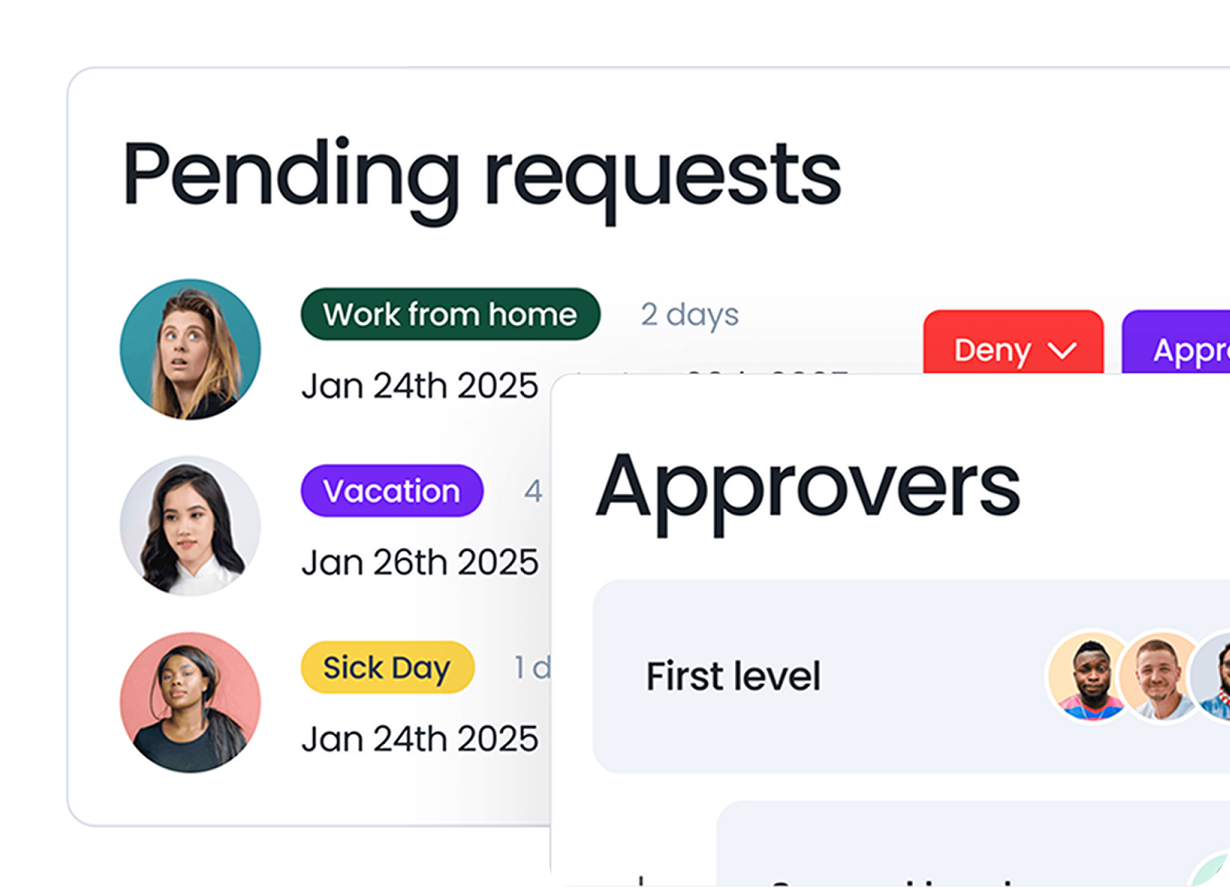Last updated on August 26, 2024
Different Types of Leave to Include in Your Leave Policy
HR departments are the heartbeat of a thriving workplace, balancing employee benefits and company culture to create a happy, healthy, and engaged team. From sick leave to sabbaticals, understanding the different types of leave can make all the difference in building a supportive workplace. In fact, a recent survey reported that 80% of employees prefer additional benefits over a pay increase (HCAMag).
The types of leave from work vary depending on each country’s leave laws. However, nothing prevents your company from offering additional leave benefits to increase retention rates and overall employee satisfaction.
In this article, we explore 17 different types of leave to inspire your benefits package, help ensure compliance, and make your team feel appreciated. We’ll primarily explore US leave laws and see how they stack up in comparison to the rest of the world, including North American, Australian, and European leave laws. Let’s dive in!
What is leave from work?
Work leave refers to the time that employees are entitled to take off work for vacation, holidays, illness, or various other reasons. Federal law grants employees a certain number of days off work, but companies can choose to incorporate additional days or types of leave in their compensation package to better support their teams. There are several different types of leave from work. Let’s explore some of those together.
17 Different Types of Leave to Include in Your Leave Policy
Standard Paid Leave
Annual Leave
Annual leave, sometimes called vacation leave, provides employees with paid time off for rest and recreation. It is usually granted annually or as monthly or quarterly accruals, but sometimes, companies offer unlimited time off. Though the U.S. doesn’t require paid vacation leave by federal law, many companies choose to provide it to improve employee satisfaction and retention. Most countries have laws mandating a minimum amount of paid vacation days, with Australia offering four weeks and Canada two.
Public & Religious Holidays Leave
Each country has designated paid public and religious holidays that must be respected by all companies that operate in that area. Some examples in the US include Christmas, Thanksgiving, and Independence Day. This is something to be particularly cautious of when creating a leave policy for remote or global companies, as employees from different countries may have different holidays.
Privilege Leave
Privilege leave is a way companies can choose to reward employees for their loyalty and dedication. Granted based on tenure, this flexible type of leave allows employees to take time off for a variety of reasons—whether it's for a well-deserved vacation, handling personal matters, or even managing unexpected emergencies.
Compensatory Leave
Compensatory leave, or “comp time,” is paid leave given to employees who exceed their work hours but are not entitled to overtime pay. To ensure fairness and transparency, it's important to let employees know in advance if they have earned extra hours or days for leave.
Family and Caregiving Leave
Family and Medical Leave (FMLA)
The Family and Medical Leave Act (FMLA) offers a lifeline for employees facing critical moments, including welcoming a new child or caring for a loved one during a health crisis. This leave is unpaid but allows employees to keep their group health insurance coverage. US employees are allotted 12 weeks of FMLA leave, but in Canada, it goes up to 28 weeks. Studies show that Paid Family and Medical Leave have positive impacts on families, including lower infant mortality rates and better maternal mental health, without placing significant costs on employers (AnnualReview).
Maternity Leave
Maternity leave allows new mothers to recover from childbirth and take care of their newborn. Unlike most developed countries, the United States does not offer paid parental leave, but employees are entitled to unpaid time off under the FMLA. Leave policies vary greatly across countries, so it's important to structure your policy according to local laws and best practices.
Paternity Leave
Like maternity leave, paternity leave supports fathers or partners in adjusting to their new family roles. Including any form of parental leave, your policy can foster a more inclusive, family-friendly workplace.
Religious Observance Leave
Religious observance leave is meant for employees who participate in religious festivals, customs, or festivities that are not recognized as official religious holidays by the country’s government. While the decision to offer paid or unpaid religious observance leave is at the employer’s discretion, providing this flexibility promotes diversity and inclusion, showing that your company values the personal beliefs and traditions of every employee.
Health and Wellness Leave
Sick Leave
Sick leave allows employees to focus on their health when they are feeling unwell. By providing paid sick leave, you not only care for your employees but also help prevent illness from spreading through the office.
The United States is the only developed country that doesn’t have mandated paid sick days, but companies often choose to include some in their policy to ensure their team has the support they need when it matters most. Unfortunately, 22% of Americans still have no paid sick days (U.S. Bureau of Labor Statistics). While often federally mandated, policies for paid sick leave vary globally in terms of the number of days and salary percentage.
Bereavement Leave
Bereavement leave gives employees the time to process the loss of a loved one, attend the funeral, and begin healing. Despite not being required by law in all countries, including the US, many companies have it as part of their leave policy.
Casual Leave
Casual leave is spontaneous time off due to unexpected situations. This leave is often taken at the last minute, allowing employees to respond to unforeseen circumstances, including personal or mental health reasons, without using up all their sick days or vacation time.
Adverse Weather Leave
Adverse weather leave is used when the weather makes it challenging or unsafe for employees to travel. In these situations, employers will need to allow their team to take time off to ensure their safety. They can either take a day from their PTO balance, or some organizations grant employees time off for these specific situations, although employees are expected to make up for that time later.
Professional Development Leave
Study Leave
Study leave allows employees to gain new knowledge and skills by attending university or learning. It is typically offered on a case-by-case basis at the employer’s discretion. Study leave is more likely to be approved if the advancement is relevant to the company’s growth.
Sabbatical Leave
Sabbatical leave is an extended leave often meant for personal development, research, or rest.
It is commonly used in academic institutions by professors who are stepping away from teaching to focus on their research. Organizations can choose to offer paid, partially paid, or unpaid sabbaticals, since it’s not government-mandated, it’s completely up to their discretion.
Civic Leave
Voting Leave
Voting leave is time off during the official election days to allow everyone an equal voting chance. It usually covers an hour or more during the day, depending on the company leave policy, and it should be strictly used to fulfill this civic duty. There’s no federal law mandating that employees get time off to vote in the US, although 30 states have laws in place. The Canada Elections Act states that all employees eligible to vote must have three consecutive hours available in their day to vote, and if their work schedule prohibits this, they are entitled to modified hours or work leave.
Jury Duty Leave
Jury duty leave allows employees who are called for jury duty to perform their civic duty. These policies largely depend on the country’s juridical system and are not mandatory in all countries. Some regions have specific laws requiring jury duty leave to be paid, while others may offer only unpaid leave, and some offer none at all.
Military Leave
Military leave ensures that employees serving in the armed forces, whether for active or inactive duty, have job security. Family military leave is a condition under the FMLA that protects family members, allowing them to take time off to adjust after a spouse’s deployment or to care for a family member who was wounded during service.
Manage Employee Leave Policies and PTO with Vacation Tracker
Vacation Tracker is a leave management software that can help you stay organized and up to date regarding your team’s PTO trends. It allows employees complete visibility into their PTO balance and leave types, allowing them to make requests directly through our user-friendly self-service portal. Administrators can approve or deny requests and get informed about the employees’ time off in just a few clicks.
Easily adjust to different companies’ structures and work models by customizing your leave types in Vacation Tracker, ensuring compliance in each of your employees’ countries.
Vacation Tracker integrates with Slack or Microsoft Teams so that you can do all this and more without leaving your company chat!
Tracking Can Be
Learn how to manage time off without
confusion, delays, or admin headaches.





